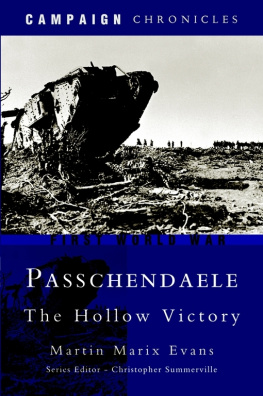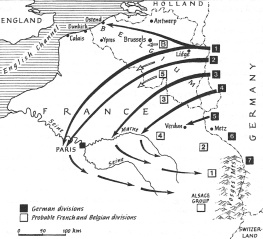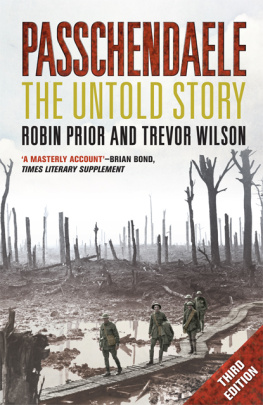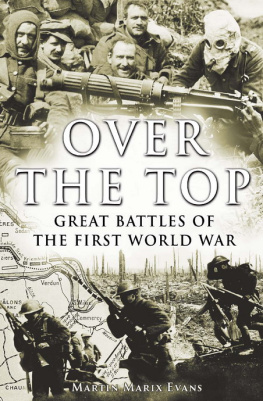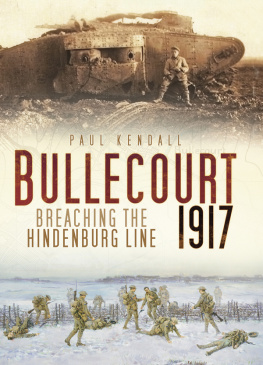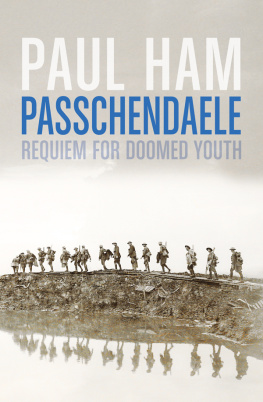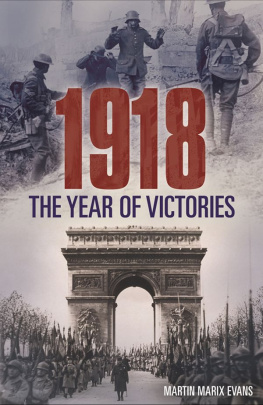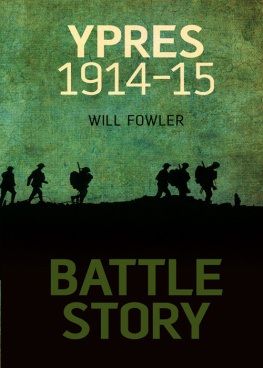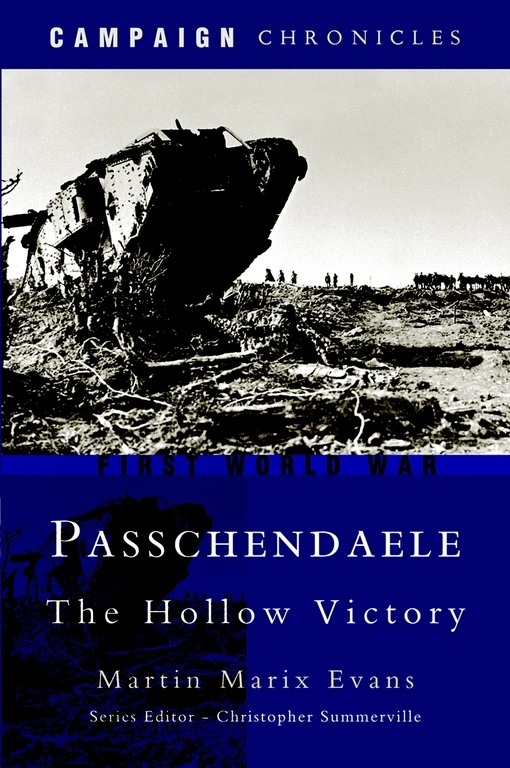I am grateful to David Fletcher of the Tank Museum, Bovington, for first drawing my attention to the history of the tanks in the Third Battle of Ypres and guiding my reading on the subject. He is not responsible for my errors. Peter Doyle revealed the importance of the underlying geology to me and Henrich Dirksen sent me valuable German accounts of the events in the salient, which Michael French rendered vividly in English. Ian Parker has kindly granted permission for the use of his fathers words. David Stanley and his volunteers made me welcome to and gave me the run of the archives of the Oxfordshire and Buckinghamshire Light Infantry in Horspath, Oxford, which enabled me to reproduce detailed mapping of their operations. The sources of the illustrations are given in the captions and I am obliged to the institutions concerned for permission to use them.
When I undertook this work I anticipated a task of selection and collation of eye-witness accounts which would produce a clear story. Instead it became a search for coherence and a sifting of conflicting views, an attempt to balance the detailed with the broad picture from which each reader can generate a personal opinion, for firm conclusions do not emerge, except for the fact that most of the firm opinions expressed in the past are mistaken.
Specific enquiries on the source of a given quotation or statement, with page references, may be addressed to the author care of the publishers, which may help readers in place of footnotes.
Biographical Notes
Birdwood, Lieutenant General Sir William (1865 1951) . Birdwood was a professional cavalry soldier and protg of Lord Kitchener, which did not endear him to Haig. He was given command of the Australian Imperial Force in 1915 and led them at Gallipoli, on the Somme in 1916 and at Ypres he commanded I ANZAC Corps. In May 1918 Monash succeeded him and Birdwood took command of the Fifth Army.
Byng, General Sir Julian (1862 1935) . Byng was in command of the Cavalry Corps in 1915 when he was sent to organize the successful withdrawal from Gallipoli. He returned to the Western Front to command the Canadian Corps. In June 1917 he assumed command of the Third Army and planned the Battle of Cambrai. He was Governor-General of Canada from 1921 26.
Cavan, Frederick Rudolph Lambart, tenth Earl of (1865 1946) . Cavan took command of the newly formed Guards Division in August 1915. He was promoted head of XIV Corps in December and led them on the Somme, when the first use of tanks was made in September 1916, and at Ypres the following year. He was sent to Italy in October 1917 where he was eventually given command of the Italian Tenth Army.
Charteris, Brigadier General John (1877 1946) . As senior intelligence officer on Haigs staff, Charteris was responsible for the assessments of German strength and intentions that influenced the battles of Arras and Messines, as well as Third Ypres. Both Gough and Plumer regarded his reports as being more designed to tell Haig what he wanted to hear than to reflect the facts. He was not liked by his colleagues and after Passchendaele he was removed, becoming a deputy director of transportation.
Currie, Lieutenant General Sir Arthur William (1875 1933) . Currie succeeded Byng in command of the Canadian Corps and led his countrymen at Third Ypres. He showed his skill and independence of mind in the attack at Lens in August 1917, ordered as a distraction from Ypres, but under Currie ending as the successful seizure of Hill 70. He resisted Haigs pressure to hurry into action against Passchendaele and ensured that preparations were thorough.
Elles, Brigadier General H J (1880 1945) . Elles was on Haigs staff when he was sent to report on trails with the tracked vehicles, which were developed as tanks. He commanded the Armoured Car Section of the Motor Machine-Gun Service: the first name given to the tank formation, before it became the Heavy Section, Machine-Gun Corps, and finally the Tank Corps. The Battle of Cambrai demonstrated the truth of Elless assertion the tanks should be used to operate on good going in the van of the battle.
Godley, Sir Alexander John (1967 1957) . Godley was Commander-in-Chief of the New Zealand Expeditionary Force as well as commander of II ANZAC Corps. His style of headquarters-based control was unsuited to the conditions of Gallipoli and he contributed to the failure at Sari Bair. In Flanders his formation fought at Messines, and then at Passchendaele, where he ignored Monashs advice to make thorough preparations for attack. He took over XXII Corps in 1918, fighting successfully under French command, and then III Corps, which fought well in the battles of August 1918.
Gough, General Sir Hubert de la Poer (1870 1963) . Gough became the youngest British Army commander of the war, having led a cavalry brigade and then a division in 1914, and an infantry division and then a corps in 1915. His impressive performance led to his being given command of the Reserve Army, intended for use after the breakthrough, in May 1916. As commander of the Fifth Army he won the Battle of the Ancre in November 1916. The aggressive vigour he showed led to the Fifth Army being chosen to spearhead the Flanders campaign in 1917. Goughs handling of the Fifth Army against the German assault of March 1918 showed him to be a master of open warfare, but the massive retreat required a scapegoat and he suffered accordingly.
Haig, Field Marshal Sir Douglas (1861 1928) . Haig commanded I Corps of the BEF in 1914 and played a minor part in operations until the First Battle of Ypres in October/November, when his coolness under immense pressure was essential to success. He was made Commander-in-Chief of the BEF in December 1915 and presided over the terrible losses on the Somme on 1 June 1916, when he failed to press his advice to modify plans on the field commander, Rawlinson. Haig remained committed to securing victory on the Western Front, but clung to the questionable objective of a breakthrough. After Third Ypres he was obliged to take over a greatly lengthened front line without matching reinforcements and the Fifth Army was almost broken in consequence. Haig remained steady under the pressures of retreat and then presided over the vindication of the new weapons systems in the victory of 1918.
Jacob, Lieutenant General Sir Claud William (1863 1948) . Jacob commanded II Corps, later Fifth Army, under Gough from August 1916. He was charged with the capture of the Gheluvelt Plateau on 31 July 1917 and, in spite of his confidence, failed in a succession of costly fights. He oversaw the withdrawal of the British from Passchendaele Ridge in April 1918 and the advance over the same terrain that autumn.
Kiggell, Lieutenant General Sir Launcelot Edward (1862 1954) . At the end of 1915 Kiggell became chief of staff to Haig and served him through the great battles of the Somme and Third Ypres, only to be retired as a sop to politicians after that expensive campaign. The story that he burst into tears when he saw the battlefield, saying Good God! Did we really send men to fight in that? is without reliable foundation.
Kuhl, General Herman von (1856 ?) . Kuhl was chief staff officer to Prince Rupprechts Army Group, having held the equivalent post under the same commander in the Sixth Army. He was influential in the decision to withdraw to the Hindenburg Line in 1917 and he argued for the evacuation of the Messines Ridge, but local commanders prevailed with their protests that they could hold it. After Third Ypres he advocated an attack south of the salient and, although his plan was diluted by other offensives, it came close to success.

